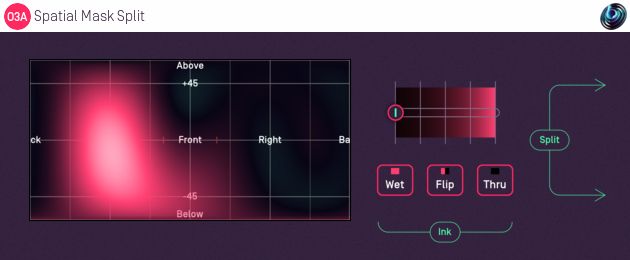O3A Spatial Mask Split

Host Support
| Host Type | Support |
|---|---|
| AAX | No |
| VST2 | Yes |
Audio
| Channels | Content | |
|---|---|---|
| Input | 16 | O3A |
| Output | 32 | Two split O3A mixes |
Controls
Description
This plugins separates the content of an O3A stream into two that can be joined together later. The separation is controlled by painting regions.
This plugin is a variant of the O3A Spatial Mask plugin. Whereas that plugin produces 16 channels of output containing a single O3A scene, this plugin produces 32 channels of output, containing two O3A scenes.
The first 16 channels of output contain the masked scene as before, but the second 16 channels contain the rest of the original scene. These two sets of channels can be added back together to reconstruct the original input mix with the O3A Join plugin.
This can be useful when you want to apply processing just to the masked region, leaving the rest of the original scene intact. In Reaper, placing a normal 16 channel O3A manipulator on a 32 channel track applies the manipulator to the masked region (the first 16 channels) only and everything else passes through unaffected. This can all then be joined back together.
The plugin is available in the O3A Manipulators plugin library.
Controls
Control: Ink Control
The first horizontal slider selects the colour of the "ink" that will be used when the panel is painted on. The grey tick marks are 6dB points.
Control: Thru Button
This instantly paints the entire canvas dark ("Thru"). This means that all sound directions are then passed to the second O3A mix.
Control: Wet Button
This instantly paints the entire canvas light ("Wet"). This means that all sound directions are then passed to the first O3A mix.
Control: Flip Button
This instantly converts the parts of the canvas that were light to dark and the parts that were dark to light and so on. This has the effect of switching which O3A output sounds are sent to.
Controls: ACN00 - ACN15 Elements
These controls are not shown on screen as numbers but are available for automation. They capture an internal representation of what is on the canvas and they can be used to automate the canvas. If you are recording them, make sure you record them all together!
We recommend that you do not attempt to interpret these numbers. However, it may be worth knowing that fading them together (linearly) will result in a natural (linear) fade of the canvas image.
Technically, these elements contain a spherical harmonic decomposition of the gain function, defined as a function mapping the surface of the unit sphere to values broadly between 0 and 1, where the spherical harmonics are encoded using the SN3D convention.
- O3A A20->B Converter
- O3A B->A20 Converter
- O3A Compressor
- O3A Diffuser
- O3A Directional Emphasis
- O3A Directional Mask
- O3A Graphic Equalizer
- O3A Join
- O3A Line
- O3A Low/High Pass Filter
- O3A Move
- O3A Order Amplifier
- O3A Panner LS
- O3A Panner LS XYZ
- O3A Panner LS8
- O3A Parametric Equalizer
- O3A Portal
- O3A Reflection
- O3A Screen Resizer
- O3A Spatial Equalizer
- O3A Spatial Mask
- O3A Spatial Mask Split
- O3A Spotlight
- O3A Spotlight Split
- O3A Swap
- O3A Zoom
- O3A Zoom XYZ
